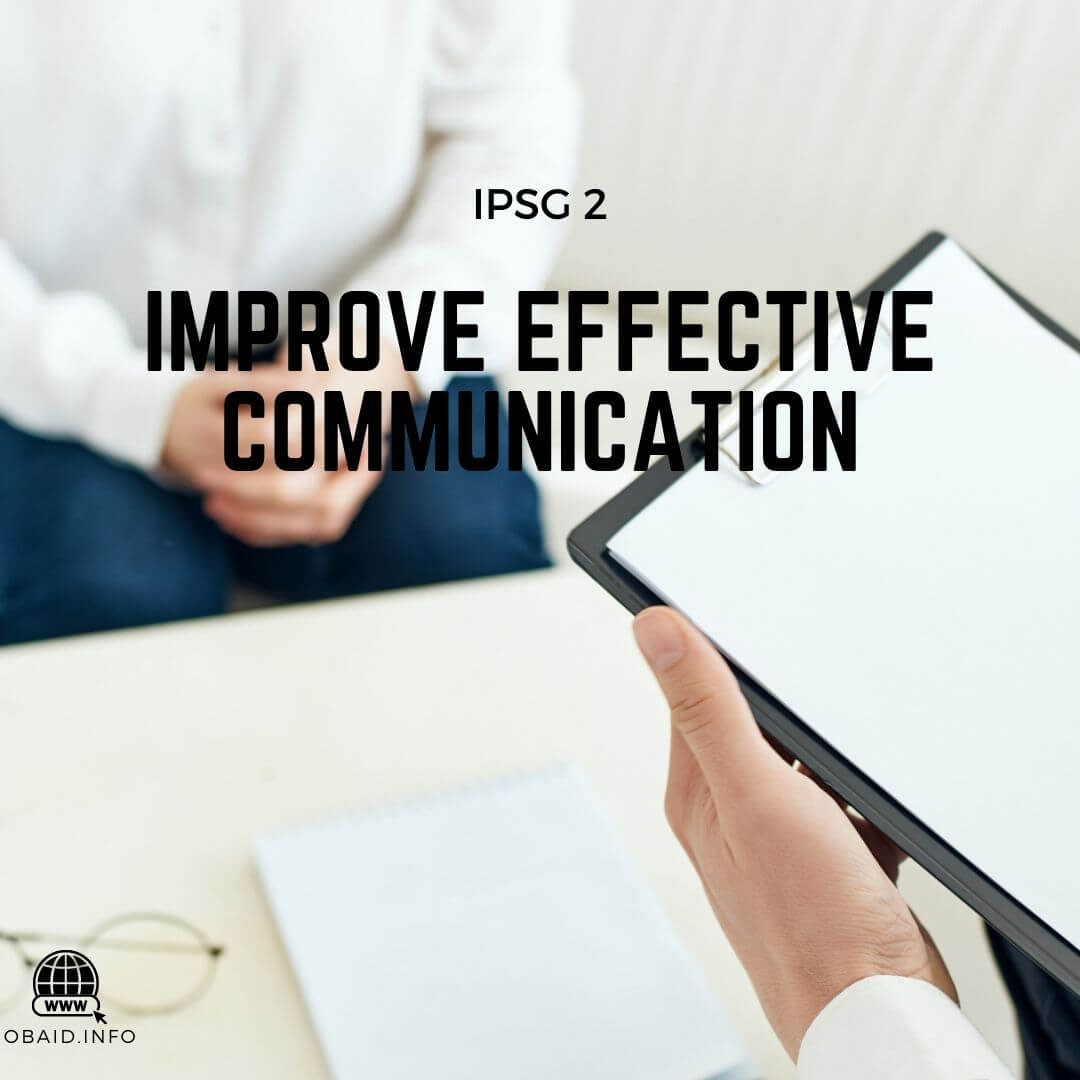I. Introduction
A. Brief explanation of International Patient Safety Goals.
The International Patient Safety Goals (IPSG) are a set of guidelines and objectives that aim to enhance patient safety and improve healthcare outcomes worldwide. These goals were developed by The Joint Commission International (JCAHO) in 2006.
The IPSGs provide a framework for healthcare providers to implement safety measures and practices that are designed to reduce medical errors and prevent adverse events. The goals cover a wide range of areas including medication safety, infection prevention, patient identification, and communication.
B. Overview and importance of Goal Two: Improve Effective Communication.

By adhering to these goals, healthcare organizations can ensure that they are meeting global patient safety standards and promoting a culture of safety within their facilities. The IPSGs are regularly updated to reflect emerging risks and changes in healthcare practices, and healthcare providers are encouraged to stay informed and implement these goals in their respective organizations.
Ultimately, the IPSGs aim to improve the quality of care and promote patient safety on a global scale.
C. How communication impacts patient safety.
- Effective communication ensures that important information is properly conveyed between healthcare professionals, patients, and their families.
- When communication fails, patient safety is at risk.
- Misunderstandings, inaccuracies, and incomplete information can lead to errors in diagnosis, medication administration, and treatment plans.
To enhance patient safety, healthcare organizations must implement strong communication strategies.
These strategies include clear and concise verbal communication, written communication that is easy to understand, and the use of technology to improve communication efficiency.
Communication errors, such as misinterpretation of information and lack of information sharing, can have severe consequences for patient safety. Therefore, it is crucial for healthcare providers to recognize the link between communication and patient safety and to continuously improve their communication skills and systems.
Overall, effective communication plays a vital role in ensuring patient safety and must be prioritized in healthcare settings.
II. Understanding Communication in Healthcare
A. Discuss the role of effective communication in healthcare.
Effective communication in healthcare can save lives through:
- Accurate transmission of information to ensure timely diagnosis and treatment.
- Rapid response during emergencies by relaying critical patient information promptly.
- Patient education and empowerment, leading to better adherence to treatments and proactive healthcare-seeking behavior.
- Coordinated care among healthcare teams, minimizing errors and ensuring seamless transitions.
- Clear instructions for post-discharge care, promoting positive patient outcomes.
B. Different types of communication methods in healthcare (Verbal, Written, Non-verbal).

Verbal communication is one of the most common types, where healthcare providers directly interact with patients, other healthcare professionals, and support staff to convey instructions, medical histories, or treatment plans.
This can include providing a verbal order for a medication or treatment. Written communication, on the other hand, involves the use of documentation such as medical records, charts, and reports to capture and convey detailed information.
This is particularly important for accurately documenting patient histories, treatment plans, and progress notes.
Non-verbal communication includes the use of body language, facial expressions, and gestures to express or interpret meaning. This type of communication plays a crucial role in patient assessment, as healthcare professionals often rely on visual cues to evaluate patients’ conditions and emotional well-being.
It is especially important in emergency situations where patients may be unable to communicate verbally.
Additionally, telephone orders are commonly used in healthcare settings, particularly for urgent situations or when healthcare providers are not physically present. However, it is essential to exercise caution when using this method to ensure accuracy and prevent miscommunication, particularly when it involves high-alert medications or other critical interventions.
Overall, effective communication is a must for achieving International patient safety goal two.
C. Address the common miscommunications in healthcare.
- A doctor prescribes 50 mg of medication, but the nurse administers 500 mg instead.
- A patient mentions having a rash, but the healthcare provider hears “rash” as “rush” and not “rash,” leading to a misdiagnosis.
- An elderly patient says they feel “dizzy,” but the healthcare professional misunderstands it as “busy” and does not address the underlying issue.
- A nurse instructs a patient to take their medication “once daily,” but the patient interprets it as “twice daily” and takes double the prescribed dose.
- A non-English speaking patient tries to explain their symptoms using gestures, but the healthcare provider fails to understand and misinterprets their condition.
- During a phone conversation, a physician asks about any allergies, and the receptionist mistakenly records “no allergies” instead of the correct response.
- A surgeon requests a specific surgical procedure, but due to poor handwriting in the surgical notes, another surgeon performs an incorrect site / body part.
- A pharmacist misreads a prescription dosage of 10 ml as 100 ml and dispenses ten times more medication than needed.
- The caregiver fills out a form indicating that the patient is allergic to penicillin, but this information is overlooked by subsequent healthcare providers who prescribe antibiotics containing penicillin.
- A patient describes chest pain as being sharp and intense, but the nurse documents it as mild and dull ache, potentially leading to improper treatment decisions.
III. Exploring Goal Two – Improve Effective Communication
A. Detailed analysis of the goal’s significance and why it should be prioritized.
IPSG.2 States “The hospital develops and implements a process to improve the effectiveness of verbal and/or telephone communication among caregivers.“
As we discussed before, verbal orders and telephone orders are incredibly important and shouldn’t be treated lightly.
To comply with this requirement, hospitals are expected to establish a structured process that focuses on improving both verbal and telephone communication. This may involve creating guidelines or protocols for clear and concise communication, standardizing terminology to avoid misunderstandings, and utilizing appropriate tools or technologies to support effective telephonic exchanges.
Verbal order example
here’s an example of a verbal order:
Let’s say a physician is on rounds and encounters a patient who needs a change in their medication. The physician verbally communicates their order to the nurse by saying, “Please administer 10 milligrams of medication X intravenously every six hours to Patient A.”
In this scenario, the physician provides the necessary information verbally to the nurse, specifying the medication, dosage (10 milligrams), route of administration (intravenous), frequency (every six hours), and the intended recipient (Patient A). The nurse then documents this verbal order and proceeds to carry it out accordingly.
Here’s an example of a telephone order:
Let’s say a physician is off-site or unable to be physically present at the hospital, but needs to provide an order for a patient. In this case, the physician calls the nurse on the phone and provides the following order: “Please increase Patient B’s insulin dosage to 20 units subcutaneously before each meal.”
In this example, the physician communicates the necessary information verbally over the phone. The order specifies the patient (Patient B), the medication (insulin), the dosage (20 units), and the route of administration (subcutaneously) before each meal.
Upon receiving a telephone order, it is crucial for healthcare professionals to follow established protocols for accurately documenting and verifying the order. This typically includes reading back and confirming the details of the order with the physician to ensure clarity and prevent miscommunication.
Orders for the following medicines cannot be made or received over the phone.
- Hazardeous Medications
- TPN
- Narcotics or Controlled items
All telephone orders and verbal orders must be signed, timed, and dated by all nurses and physicians who are involved in the procedure.
ISBAR

The isbar technique below should be used in every communication between the staff.
- Identify, yourself and the patient
- Situation, what is the problem
- Background, information to contextualize the problem
- Assessment, your clinical assessment and prediction
- Recommendation, what you think should happen
B. How IPSG2 improves patient care
International Patient Safety Goal 2 primarily focuses on improving the effective communication in healthcare settings to drastically reduce the risk of patient harm.
Broadly, it aims at fostering a culture of open, clear and timely communication to augment the quality of patient care.
Efficient communication plays a crucial role in almost every aspect of healthcare, notably including diagnosis, treatment planning, medication prescription and patient follow-up visits.
By prioritizing this goal, the likelihood of misunderstandings or misinterpretations that could potentially lead to medical errors or patient harm is significantly decreased.
In an aspect as crucial as handling high alert medications, which typically bear high risks and repercussions when misused or mishandled, effective communication becomes even more significant. It improves the safety of high-alert medications by ensuring that the right medication, in the correct dosage, is handed to the right patient the right way at the right time.
Methods of communication like using standard terminologies or abbreviations, using patient identifiers and maintaining clear, complete and up-to-date medication records can further minimize the possibility of harmful medication errors. Hence, by enhancing productive communication, International Patient Safety Goal 2 contributes vastly to enhancing the overall patient care and ensuring safety in the healthcare environment.
C. The challenges in achieving effective communication in healthcare.

Effective communication is a critical component in healthcare, both in terms of patient care and the functioning of the healthcare system. There are several challenges that can hinder achieving effective communication:
- Language and Cultural Barriers: Patients from diverse cultural backgrounds or those who speak different languages may face communication issues with healthcare providers. This could lead to misinterpretation of symptoms, incorrect diagnoses, improper treatment suggestions, and potential dissatisfaction with care.
Here’s an illustrative example of how language and cultural barriers can create difficulties in a hospital setting:Dr. Williams, a skilled cardiologist, has a new patient, Mrs. Martinez. Mrs. Martinez is a recent immigrant from Mexico and speaks only Spanish. She comes to the hospital with severe chest pain.
- Health Literacy: Not all patients have a high level of health literacy. They might struggle to comprehend medical terminology, thereby misunderstanding their condition or treatment plan.
Imagine a scenario where a patient named Mrs. Johnson visits her doctor for a routine check-up. During the visit, the doctor hands her a prescription for a medication and offers some basic instructions about when and how to take it.
The instructions may sound simple: “Take one pill twice a day, with food.” However, Mrs. Johnson does not have a high level of health literacy. She doesn’t fully understand what the doctor means by “with food” – does that mean she should take the pill during her meal, or is it okay to take it after? She’s also unsure of what “twice a day” means in this context – should the doses be 12 hours apart, or can she take one in the morning and one at night?
Mrs. Johnson is too embarrassed to ask these questions, so she leaves the doctor’s office with her prescription, planning to guess at the answers on her own. This could potentially lead to her misusing her medication, which could in turn have adverse effects on her health.
This example illustrates how important health literacy is – not just for patients’ understanding of their own health and treatment, but also for their ability to make informed decisions about their healthcare.
- Time Constraints: Healthcare professionals often work under significant time pressure. This can lead to rushed consultations where important information might be missed or not adequately explained.
Here are a few examples of how healthcare professionals often work under significant time pressure:Emergency Room Physicians: These doctors are constantly under time pressure as they need to quickly diagnose and stabilize patients. They often have to prioritize patients based on the severity of their conditions. This is especially true during peak hours or in situations where there are more patients than the staff can handle.
Surgeons: Operations need to be completed within a certain time frame to ensure the patient’s safety and quick recovery. Unforeseen complications can extend the duration of the surgery, adding additional time pressure.
Nurses: They need to manage multiple patients at once, administer medication on schedule, and respond to emergencies. All these tasks need to be completed in a timely manner.
General Practitioners: They often have back-to-back appointments. Each appointment slot is usually 15-30 minutes long. They have to diagnose, recommend treatment, and sometimes even counsel patients within this short time frame.
Pharmacists: They must accurately fill prescriptions while managing inventory and assisting customers. During busy hours, the time pressure can be immense.
Radiologists: They have to read and interpret numerous scans and images each day. Each reading must be done carefully to avoid misdiagnosis, but also promptly to provide timely results for further treatment.
All these professionals often work under significant time pressure, making efficiency and accuracy crucial in their roles. - Emotional Factors: The emotional state of patients can significantly influence their ability to communicate effectively. Fear, stress, or anxiety may prevent them from sharing important details about their health condition.
Examples illustrating how emotional factors can impact patient communication:
- Fear of Diagnosis: For instance, a patient may have noticed a lump in her breast but is too terrified to mention it to her doctor because she fears it may be indicative of breast cancer. The fear inhibits her ability to communicate this crucial piece of information.
- Anxiety about Treatment: A patient suffering from chronic pain might be resistant to discussing alternative treatments with their physician due to the anxiety surrounding potential side effects or the fear of the unknown.
- Stress from Past Experiences: Patients who have had negative experiences with healthcare providers in the past may feel stress and anxiety when it comes to sharing their symptoms or concerns, hence impeding effective communication.
- Emotional Overwhelm due to Serious Illness: When patients are diagnosed with serious illnesses like cancer, the shock and emotional turmoil can make it hard for them to absorb information or communicate about their treatment options effectively.
- Depression and Lack of Motivation: Patients dealing with depression may lack the motivation or energy to communicate effectively about their health condition. They may neglect to mention symptoms or may not fully engage in conversations with healthcare providers.
It’s essential for healthcare providers to recognize these emotional factors and approach patient communication with empathy, patience, and understanding. They should create a safe and comfortable space for patients to express their worries and fears.
- Information Overload: The amount of information that needs to be communicated in a clinical setting can sometimes overwhelm both patients and healthcare providers leading to miscommunication.
Here’s an example:
Dr. Smith is a cardiologist who is treating Mr. Thompson, a 65-year-old patient with a history of heart disease and diabetes. During a regular checkup, Dr. Smith needs to discuss several important issues with Mr. Thompson:
- The results of his recent blood tests
- Changes in his medication regimen
- The importance of maintaining a healthy diet and exercise routine
- Recent research findings related to heart disease and diabetes
- Instructions for managing potential side effects of new medications
- Scheduling future appointments and diagnostic tests
Additionally, Dr. Smith needs to communicate with other healthcare providers involved in Mr. Thompson’s care, such as his primary care physician, endocrinologist, and physical therapist.
At the same time, Mr. Thompson is trying to understand all this complex medical information, remember all the instructions, and communicate his concerns and questions to Dr. Smith.
This situation can lead to information overload for both Dr. Smith and Mr. Thompson, increasing the risk of miscommunication, misunderstanding, and mistakes in Mr. Thompson’s care. This is a perfect example of how too much information can sometimes be as problematic as too little information in a clinical setting.
Inter-professional Communication: Effective communication between different healthcare professionals is crucial for coordinated and efficient patient care which is often challenging due to differing terminologies among specialists.
Let’s consider a scenario involving a patient who has been admitted to the hospital due to a stroke. The patient care team consists of several different specialists including a neurologist, a cardiologist, a nurse, a physiotherapist, and a social worker.
- Different Terminologies: The neurologist might discuss the patient’s condition in terms of cerebral infarction or brain ischemia. On the other hand, the cardiologist might refer to the same condition as a thromboembolic stroke caused by atrial fibrillation.
- Challenging Communication: The physiotherapist, focusing on the patient’s rehabilitation and mobility, might not fully understand the medical jargon used by the neurologist and cardiologist. Similarly, the social worker, who is trying to arrange post-discharge care, may not be familiar with these clinical terms.
- Technology Use: Electronic Health Records (EHRs) and other digital tools have become indispensable in modern healthcare but could also present challenges due to factors like usability issues or access discrepancies among different parties involved in patient care.

Addressing these challenges requires concerted efforts aimed at improving language services, enhancing health literacy education, managing workloads for allowing enough time per patient interaction, providing emotional support, synchronizing inter-professional collaboration better, and improving technology use within the system.
IV. How to Improve Communication
Effective and clear communication among the healthcare team, as well as between the healthcare providers and the patients, significantly enhances the safety of the patients by ensuring a proper understanding of medical conditions, treatment plans, and labs critical results.
Miscommunication or misunderstanding can lead to medical errors or complications as described before.
Promoting open conversations, using simplified and understandable medical terminology, and active listening can help to achieve better outcomes. Additionally, adopting the protocols and results communication standards set by the Joint Commission International Accreditation (JCIA) ensures a high degree of professionalism and safety in the healthcare sector. This can be achieved by frequent communication training and workshops for the healthcare staff, promoting cultural competence, and encouraging family involvement in the care journey.
A. Steps healthcare providers can take to improve communication.
Healthcare providers can significantly enhance their service delivery by taking several steps to improve healthcare communication.
- Building and strengthening healthcare communication skills such as active listening, empathy, clear verbal and non-verbal cues, and patience.
- Building team communication in healthcare settings is equally crucial for coordinated care and to prevent lapses that could affect patient outcomes.
- Leverage technology to improve communication, like using patient portals for shared decision-making.
- Development of clear and simple patient information materials, developed in various languages and formats suitable for different age groups and literacy levels.
B. The role of technology in enhancing communication.
- EHRs can improve communication among different healthcare providers and, subsequently, the continuity of patient care.
- Telehealth solutions, such as virtual health visits and remote patient monitoring, can promote better patient-provider communication as well, as patients can connect easily with their providers without traveling to a medical facility.
Frequently Asked Questions

Q: What is IPSG Goal Two – Improve Effective Communication?
A: IPSG Goal Two – Improve Effective Communication is one of the Six International Patient Safety Goals (IPSGs) developed by the Joint Commission on Accreditation of Healthcare Organizations (JCI) to improve patient safety and reduce the risk of patient harm resulting from ineffective communication in healthcare settings.
Q: What are the specific improvements in patient safety targeted by IPSG Goal Two?
A: IPSG Goal Two aims to promote specific improvements in patient safety by addressing problematic areas of patient communication that can lead to preventable harm to a patient. It focuses on enhancing open communication, effective message transmission, and accurate identification of patients.
Q: How does IPSG Goal Two improve patient safety?
A: IPSG Goal Two improves patient safety by emphasizing the importance of effective communication in healthcare settings. By identifying patients correctly, ensuring accurate transmission of information, and promoting open communication, IPSG Goal Two results in improved patient care and reduces the risk of patient harm.
Q: What is the significance of accurate patient identification in IPSG Goal Two?
A: Accurate patient identification is crucial in IPSG Goal Two because it helps prevent medication errors, incorrect patient care orders, and other communication-related mistakes. By ensuring that the correct patient is identified, healthcare providers can deliver safe and appropriate care.
Q: How does IPSG Goal Two address the risk of health care-associated infections?
A: IPSG Goal Two indirectly addresses the risk of health care-associated infections by promoting effective communication. By improving communication, healthcare providers can better coordinate infection control measures, follow proper hand hygiene protocols, and implement other strategies to reduce the risk of infections.
Q: How does IPSG Goal Two relate to the other IPSGs?
A: IPSG Goal Two is one of the Six International Patient Safety Goals (IPSGs) developed by the JCI. While each goal focuses on different aspects of patient safety, they are all interconnected and work together to improve patient care and reduce the risk of patient harm.
Q: What measures can be taken to improve effective communication in healthcare settings?
A: To improve effective communication, healthcare organizations can implement various strategies such as promoting interdisciplinary collaboration, using standardized communication tools and protocols, conducting regular training and education programs on effective communication, and encouraging open communication channels between healthcare providers and patients.
Q: How can IPSG Goal Two reduce the risk of patient harm resulting from ineffective communication?
A: IPSG Goal Two can reduce the risk of patient harm resulting from ineffective communication by addressing problematic areas and promoting specific improvements in patient safety. By enhancing communication practices, accurate patient identification, and message transmission, the goal aims to prevent errors and ensure safe patient care.
Q: What is the role of open communication in IPSG Goal Two?
A: Open communication is a key component of IPSG Goal Two as it encourages healthcare providers to communicate openly and honestly with each other, as well as with patients. By creating a culture of open communication, healthcare organizations can improve teamwork, enhance information sharing, and reduce the risk of errors.
Q: How does IPSG Goal Two contribute to the overall improvement of patient safety?
A: IPSG Goal Two contributes to the overall improvement of patient safety by addressing the root causes of patient harm resulting from ineffective communication. By promoting accurate patient identification, open communication, and effective message transmission, IPSG Goal Two helps create a safer environment for patients and reduces the risk of adverse events.










